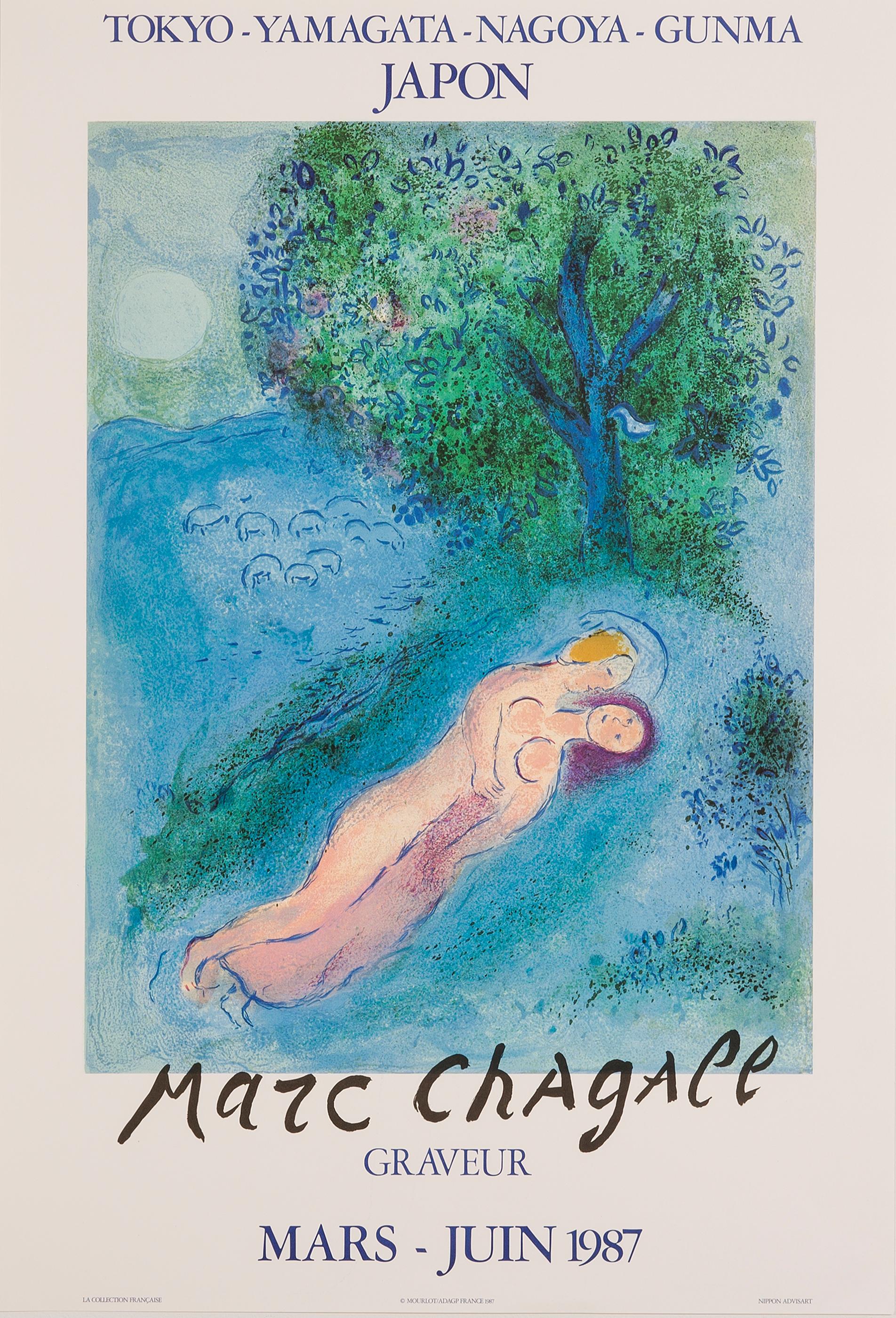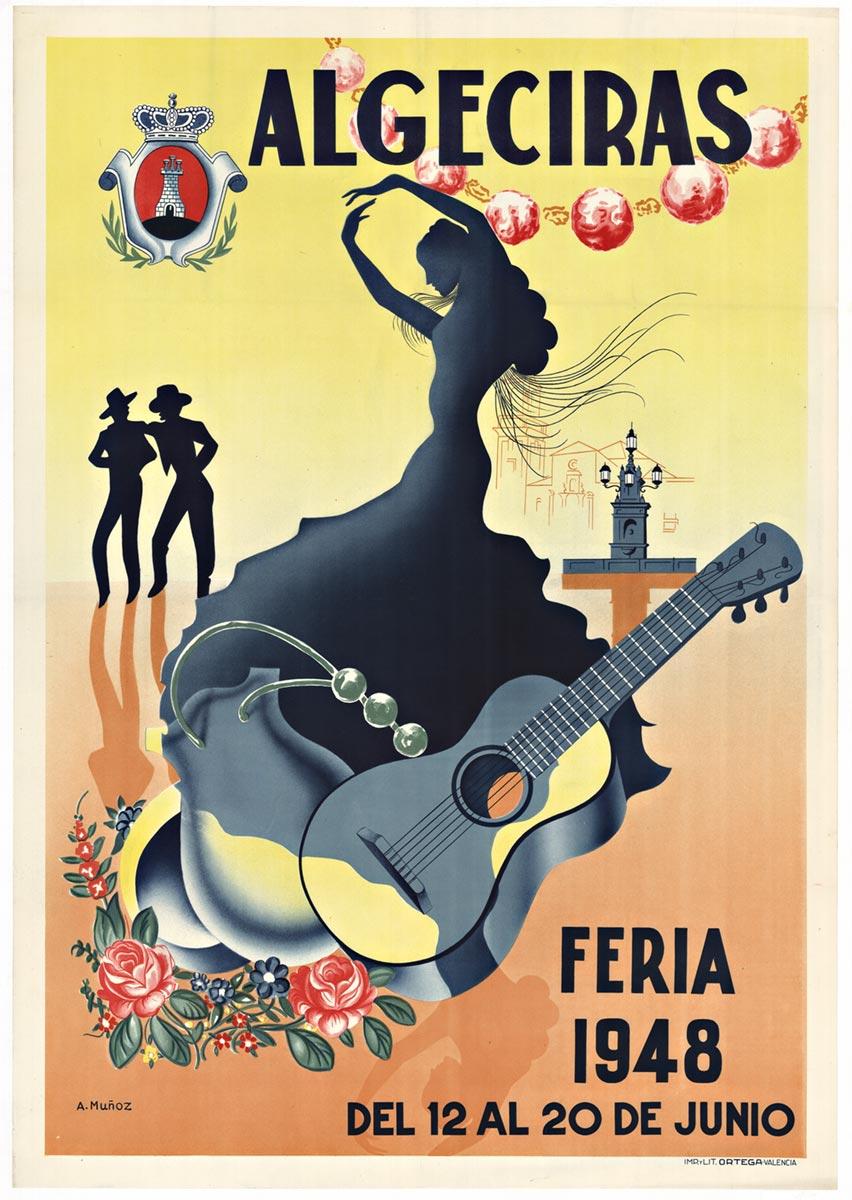Marc ChagallMarc Chagall - The Bible - Naomi and her daughters-in-law - Original Lithograph1960
1960
About the Item
- Creator:Marc Chagall (1887 - 1985, French)
- Creation Year:1960
- Dimensions:Height: 13.98 in (35.5 cm)Width: 10.24 in (26 cm)Depth: 0.04 in (1 mm)
- Medium:
- Movement & Style:
- Period:
- Condition:
- Gallery Location:Collonge Bellerive, Geneve, CH
- Reference Number:1stDibs: LU16121901393
Marc Chagall
Described by art critic Robert Hughes as "the quintessential Jewish artist of the twentieth century," the Russian-French modernist Marc Chagall worked in nearly every artistic medium. Influenced by Symbolism, Fauvism, Cubism and Surrealism, he developed his own distinctive style, combining avant-garde techniques and motifs with elements drawn from Eastern European Jewish folk art.
Born Moishe Segal in 1887, in Belarus (then part of the Russian empire), Chagall is often celebrated for his figurative paintings, but he also produced stained-glass windows for the cathedrals of Reims and Metz, in France; for the United Nations, in New York; and for the Hadassah Hospital in Jerusalem, as well as book illustrations, stage sets, ceramics, tapestries and fine-art prints. Characterized by a bold color palette and whimsical imagery, his works are often narrative, depicting small-village scenes and quotidian moments of peasant life, as in his late painting The Flight into Egypt from 1980.
Before World War I, Chagall traveled between St. Petersburg, Paris and Berlin. When the conflict broke out, he returned to Soviet-occupied Belarus, where he founded the Vitebsk Arts College before leaving again for Paris in 1922. He fled to the United States during World War II but in 1947 returned to France, where he spent the rest of his life. His peripatetic career left its mark on his style, which was distinctly international, incorporating elements from each of the cultures he experienced.
Marc Chagall remains one of the past century’s most respected talents — find his art on 1stDibs.
- ShippingRetrieving quote...Ships From: Collonge Bellerive, Geneve, Switzerland
- Return PolicyA return for this item may be initiated within 7 days of delivery.
- Jean Cocteau - Reflections - Original LithographBy Jean CocteauLocated in Collonge Bellerive, Geneve, CHOriginal Lithograph by Jean Cocteau Title: Reflections Signed in the plate Dimensions: 32 x 25.5 cm Edition: 200 1959 Publisher: Bibliophiles Du Palais Unnumbered as issuedCategory
1950s Modern More Prints
MaterialsLithograph
- Jean Cocteau - Surrealist Smile - Original LithographBy Jean CocteauLocated in Collonge Bellerive, Geneve, CHOriginal Lithograph by Jean Cocteau Title: Surrealist Smile Signed in the plate Dimensions: 32 x 25.5 cm Edition: 200 1959 Publisher: Bibliophiles Du Palais Unnumbered as issuedCategory
1950s Modern More Prints
MaterialsLithograph
- Jean Cocteau - Three Persons or One - Original LithographBy Jean CocteauLocated in Collonge Bellerive, Geneve, CHOriginal Lithograph by Jean Cocteau Title: Three Persons or One Signed in the plate Dimensions: 32 x 25.5 cm Edition: 200 1959 Publisher: Bibliophiles Du Palais Unnumbered as issuedCategory
1950s Modern More Prints
MaterialsLithograph
- Jean Cocteau - The Voice - Original LithographBy Jean CocteauLocated in Collonge Bellerive, Geneve, CHOriginal Lithograph by Jean Cocteau Title: The Voice Signed in the plate Dimensions: 32 x 25.5 cm Edition: 200 1959 Publisher: Bibliophiles Du Palais Unnumbered as issuedCategory
1950s Modern More Prints
MaterialsLithograph
- Jean Cocteau - King Oedipus - Original LithographBy Jean CocteauLocated in Collonge Bellerive, Geneve, CHJean Cocteau - King Oedipus - Original Lithograph 1956 Signed in the plate Dimensions: 66 x 50 cm Provenance : Succession Dermit, Cocteau's heirCategory
1950s Modern More Prints
MaterialsLithograph
- Jean Cocteau - Blue Eagle - Original LithographBy Jean CocteauLocated in Collonge Bellerive, Geneve, CHJean Cocteau - Blue Eagle - Original Lithograph 1956 Stampsigned lower left Signed and dated in the plate Numbered in pencil Edition : /XXV Dimensions: 50 x...Category
1950s Modern More Prints
MaterialsLithograph
- Descente aux enfersBy Georges BraqueLocated in Paris, FRLithograph on Japan Paper, 1961 handsigned by the artist in pencil 23 x 19 cm (image) - 32 x 25 cm (sheet) very good condition LCD2804Category
1960s Modern Figurative Prints
MaterialsLithograph
- La Lecon de Philetas, Les Amoureux Devant l'Arbre Exhibition PosterBy (after) Marc ChagallLocated in New York, NYThis original 1987 exhibition poster was created for an exhibition of works by Marc Chagall which travelled Japan (Tokyo, Yamagata, Nagoya and Gunma). It was printed in Paris by the famous Atelier Mourlot who printed nearly all of Chagall’s exhibition posters...Category
Late 20th Century Modern Figurative Prints
MaterialsLithograph
- La Lecon de Philetas, Les Amoureux Devant l'Arbre Exhibition PosterBy (after) Marc ChagallLocated in New York, NYThis original 1987 exhibition poster was created for an exhibition of works by Marc Chagall which travelled Japan (Tokyo, Yamagata, Nagoya and Gunma). It was printed in Paris by the famous Atelier Mourlot who printed nearly all of Chagall’s exhibition posters, as well as other famous artists of the time. Certificate of Provenance: Each individual work of art carefully curated by Mourlot Editions comes with a Certificate of Provenance, signed, dated, stamped, and numbered by Eric Mourlot. This certificate guarantees the origin and authenticity of your personal lithograph. About the Artist: 1887-1985) Russian-French Chagall was a Russian-Jewish painter...Category
Late 20th Century Modern Figurative Prints
MaterialsLithograph
- Don Quixote dans la Bibliotèque II by Bernard Buffet - signed color lithographBy Bernard BuffetLocated in New York, NYThis is a signed color lithograph by Bernard Buffet from the Don Quixote series printed in 1989 at the Atelier Mourlot, Paris. This particular image is of Don Quixote in his library....Category
Late 20th Century Modern Figurative Prints
MaterialsLithograph
- Original Inter-europäische Zusammenarbeit für bessere Lebensbedingungen posterLocated in Spokane, WAOriginal. ERP European Reunification Program, Inter-europaische Zusammenarbeit fur bessere Lebenbedingungen. Mounted on acid free archival linen. Lithography Kühn & Zoon, Rotterda...Category
1950s American Modern Figurative Prints
MaterialsLithograph
- Original Algeciras Feria 1948 vintage Spanish travel lithograph posterLocated in Spokane, WAOriginal vintage poster Algeciras Feria 1948 vintage Spanish travel poster. Archival linen backed in very fine condition, ready to frame. N...Category
1940s American Modern Figurative Prints
MaterialsLithograph





